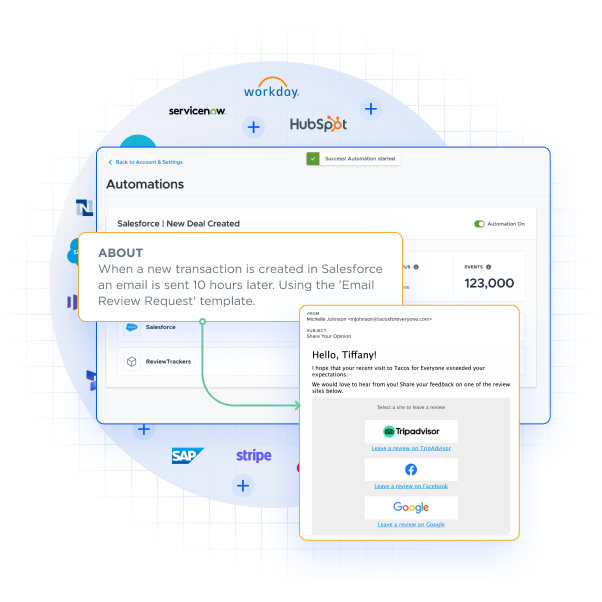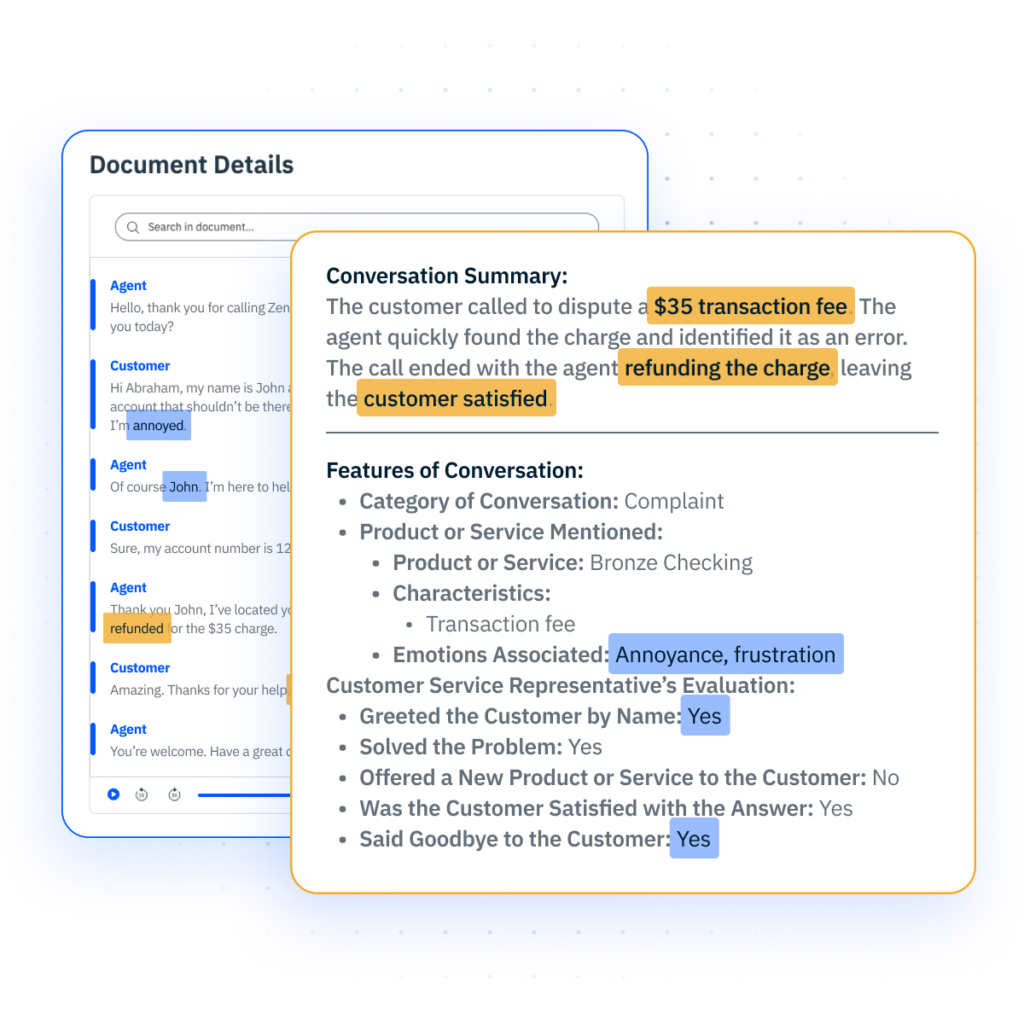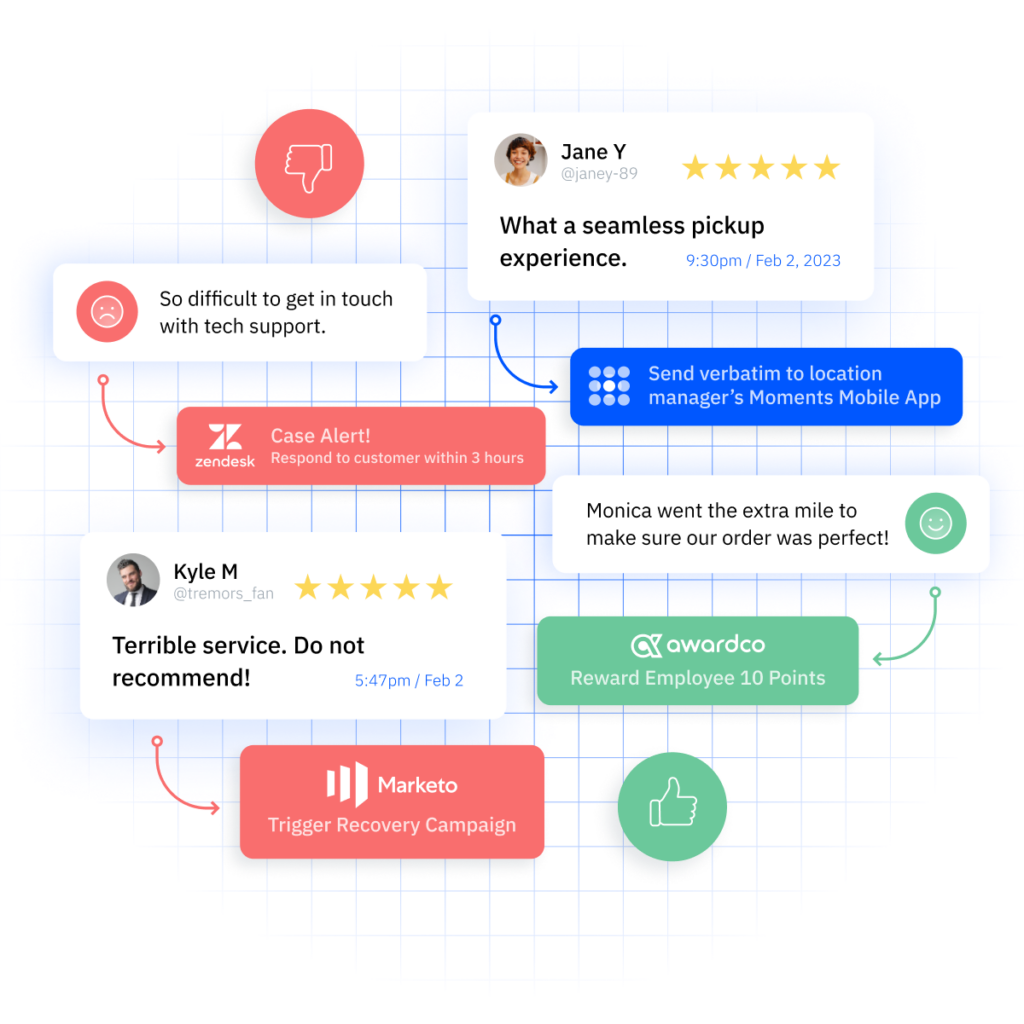How Customer Experience Automation Can Improve Business Performance
Customer experience automation is the process of automating touchpoints in the customer journey. This improves the customer experience while also giving your team more time to focus on complex customer cases.
Did you know that 92% of customer relationship management (CRM) leaders say AI and automation have improved customer service response times? Furthermore, 86% of those leaders also agree that AI and automation have helped them scale their operations, with the majority believing those tools are more effective for scaling operations than hiring more customer service representatives.
What is Customer Experience Automation?
Customer experience automation refers to automating interactions or touchpoints throughout the customer journey. This can be done using tools such as AI, natural language processing (NLP), and automated workflows. Customer experience automation allows organizations to connect with customers in a relevant, timely, and personalized way without extra manual input.
Why is Customer Experience Automation Important?
Customer experience automation is so important because 99% of service professionals at organizations who use it say that it allows them to focus on individual customers. Furthermore, an average of 90% of professionals in an organization investing in AI and automation say that it has helped reduce service costs.
Implementing customer experience automation as a regular part of your operations can help you improve business performance by cutting out the time usually needed for routine tasks and reinvesting that time in more complex customer issues, ultimately resulting in a better customer experience.
Benefits of Customer Experience Automation
The benefits of customer experience automation include:
- Enhanced efficiency
- Scalability
- Improved personalization
- Data-driven decision making
Enhanced Efficiency
Customer experience automation can reduce the workload on customer service teams by automating repetitive tasks. This allows them to focus on complex issues that require a human touch. Of the 81% of organizations automating workflow processes, 98% report that reducing errors is a major or minor benefit of customer experience automation.
Scalability
Customer experience automation systems can handle high columns of interactions simultaneously. This is useful for organizations managing an expanding customer base as their business grows. In fact, 91% of service professionals at organizations using automation have time to take on new projects due to customer experience automation.
Improved Personalization
While some may believe that automating certain touchpoints creates a similar, stale experience for every customer, the opposite is true. Over 80% of CRM leaders say that AI and automation make customer communication more personalized. Customer experience automation allows organizations to personalize more interactions based on customer data, creating an experience that is more relevant and memorable to the user.
Data-Driven Insights
Customer experience automation software can analyze automated interactions to provide insights into common customer preferences, behaviors, and pain points. Organizations that invest in AI and automation report that it has helped them better serve customers.
The Four Pillars of Customer Experience Automation
The four pillars of customer experience automation, originally developed by Gartner as the four pillars of customer service, represent the most important building blocks of customer experience automation and guide how it can be achieved. The four pillars are:
- Orchestration
- Segmentation
- Personalization
- Automation
1. Orchestration
The first pillar of customer experience of automation is orchestration. Orchestration refers to creating a cohesive and smooth customer journey. You want to ensure that interactions, whether from emails, SMS messages, chatbots, live support, or any other channel, are connected and tested before the user encounters them.
2. Segmentation
Segmentation in customer experience automation leverages customer data to group customers by behavior, preferences, or demographics. This enables more relevant and targeted communication.
3. Personalization
Personalized experiences are more than addressing customers by name. Customer experience automation can use customer data to understand purchase history and interests to craft messages that resonate with individual customers.
4. Automation
The automation pillar of customer experience automation refers to tactically scheduling, triggering, and handling responses based on customer interactions. This allows your brand to keep up with customer expectations 24/7.
Who Uses Customer Experience Automation
Various teams can use customer experience automation to accomplish different goals. Regardless of where the CX team may live in your organization, there is a place where customer experience automation can improve your performance. Here are some examples of how different teams can use and benefit from customer experience automation:
- Marketing teams
- Sales teams
- Customer support teams
- Product teams
- Operations teams
Marketing Teams
By leveraging customer experience automation, marketing teams can deliver highly personalized campaigns, segment audiences, and engage customers with relevant messaging. Setting up automated journeys, such as welcome emails and post-purchase follow-ups, helps increase engagement and build stronger customer relationships.
Sales Teams
Through automated, data-driven triggers, sales teams can leverage customer experience automation to interact with leads at the right moments. Using customer experience automation tools throughout the sales process, sales teams can nurture leads more effectively and close deals faster.
Customer Support Teams
Customer experience automation allows frontline customer support teams to automate responses to common inquiries, route tickets to the right agents, and send proactive updates. This reduces response times and allows support teams to focus on complex issues.
Product Teams
With customer experience automation, product teams can collect customer feedback, analyze customer usage patterns, and identify pain points in real time. This data-driven approach can help product teams make more informed decisions about future product features and communications.
Operations Teams
Operations teams can use customer experience automation to streamline workflows, automate data collection, and ensure consistent service delivery. From order tracking to post-purchase surveys, customer experience automation tools help operations teams optimize processes and improve efficiency.
How to Use Customer Experience Automation
Here is a quick overview of how to use customer experience automation to improve the customer journey at your organization:
- Map and Examine the Customer Journey
- Integrate Data
- Create Segments and Triggers
- Personalize at Scale
- Monitor and Optimize
1. Map and Examine the Customer Journey
If you haven’t already, you must create a customer journey map with a high-level view of the end-to-end customer experience. Once completed, you must identify the touchpoints that can be improved through customer experience automation. These touchpoints could include onboarding, feedback requests, or follow-ups.
2. Integrate Data
To effectively use customer experience automation tools, you must integrate your customer experience automation platform with your organization’s other systems. This means connecting your customer experience automation platform with CRM systems, marketing automation tools, and any other data sources that provide insights into the customer experience.
3. Create Segments and Triggers
You can create customer segments based on behaviors, demographics, and other criteria, such as purchase history or engagement level. Customer segments help you organize your customers into meaningful groups for targeted interactions.
Then, you will want to create automated triggers for each segment. Triggers prompt automated responses, such as sending a thank you email after a purchase, offering a discount to customers who haven’t engaged recently, or delivering relevant content after someone attends a webinar. Triggers allow you to respond promptly and deliver the right message at the right moment to increase engagement and conversions.

4. Personalize at Scale
Once you have this in place, you can fully implement your customer experience automation solution. Customer experience automation allows you to provide a high level of personalization for hundreds or thousands of customers simultaneously. At scale, this will improve your overall satisfaction and customer loyalty.
5. Monitor and Optimize
Continuously track the performance of customer experience automation strategies to refine and improve customer interactions over time. You can track this by monitoring pre-selected customer experience metrics to identify trends, understand customer preferences, and detect any drop-offs in the automated journey.
This data can be used to refine triggers, update personalization parameters, and adjust your customer segments. For example, if a triggered email isn’t generating clicks, it may need more compelling content or a different call-to-action.
Customer Experience Automation Examples
Here are some industry-specific examples of customer experience automation:
- E-commerce: Automated cart abandonment emails that include a personalized discount, encouraging customers to complete their purchases.
- Financial Services: Proactive notifications alert customers to unusual account activity or personalized tips to improve financial wellness.
- Healthcare: Automated appointment reminders or follow-up messages post-visit, ensuring patients feel cared for and valued.
- Hospitality: Sending personalized booking confirmations and pre-arrival checklists for a smoother guest experience.
While these examples provide a high-level overview of customer experience automation use cases, it is also important to showcase in-depth examples of organizations using customer experience automation to improve their business.
Jack in the Box
Jack in the Box struggled to provide personalized customer experiences and solicit accurate guest feedback. After choosing Pearl-Plaza as their customer experience management solution, they were able to leverage Pearl-Plaza AI and the XI Platform to automate feedback and pinpoint trends for business decisions, expedite insights across regions, and realize systemwide sales growth.
Customer Experience Automation Tools
While many organizations provide customer experience automation tools, some of the most popular are:
1. Pearl-Plaza
2. HubSpot
3. Salesforce
4. Zendesk
5. Adobe Experience Cloud
1. Pearl-Plaza

Pearl-Plaza’s customer experience automation tools are led by award-winning AI that helps organizations handle repetitive tasks, predict customer intent, and generate actionable insights. Advanced analytics features, like sentiment analysis and feedback segmentation, allow brands to uncover deep insights and make impactful, real-time improvements. With intuitive integrations and customizable reporting, this solution is ideal for enterprise organizations looking to improve the customer experience while linking CX efforts to revenue growth.
2. HubSpot

HubSpot’s customer experience automation solution is directed at frontline customer service teams that want to provide support on multiple channels. HubSpot offers automated workflows and personalized email marketing, which are ideal for engaging customers at every stage of the journey. While HubSpot is effective for smaller to mid-sized businesses aiming to build brand loyalty, its customer experience automation capabilities may require additional customization for large-scale enterprise needs.
3. Salesforce

The Salesforce CRM platform uses customer experience automation to deliver personalized customer experiences and support quality service at scale. With a vast range of integrations and robust data management features, Salesforce is a solid choice for larger organizations seeking an all-encompassing approach to customer experience. However, the platform’s complex setup and maintenance can demand significant resources, especially for companies new to customer experience automation.
4. Zendesk

Zendesk excels in customer support automation, providing tools like chatbots, ticket routing, and knowledge bases that streamline responses and improve efficiency. It’s particularly strong in service automation, making it a top choice for businesses prioritizing fast and effective support. While Zendesk is highly valuable for customer support, its customer experience automation capabilities focus more on service interactions than a complete customer journey across marketing and sales.
5. Adobe Experience Cloud

Adobe Experience Cloud offers a robust suite of tools for large enterprises aiming to personalize and orchestrate experiences at scale. With powerful analytics, real-time data integration, and content customization options, Adobe is ideal for brands leveraging data to drive engagement. However, Adobe’s features can require advanced technical expertise, and the platform is best suited for larger organizations with dedicated resources for setup and maintenance.
Customer Experience Automation Features to Look For
The performance of a customer experience automation platform will vary depending on your industry and the use cases of customer experience automation in your organization. Regardless, here are some of the most important features to look for in customer experience automation software.
- Integrations
- Call Transcriptions
- Customer Sentiment Tracking
- Employee Coaching
- Triggered Surveys
- Automated Alerts
Integrations
When evaluating a customer experience automation platform, look for a platform that can easily integrate with your existing tech stack. Ensuring that your customer experience automation platform is compatible with CRM systems, marketing automation, and data platforms will ensure a seamless data flow between tools that give teams a unified view of the customer experience. This also makes it easier to automate processes across platforms.
Pearl-Plaza’s CX integrations ensure that your team doesn’t miss a beat by letting you connect your CX data with your CRM, marketing, call center, internal collaboration tools, and more to ensure you can collaborate and amplify your CX success across your organization.

Call Transcriptions
Call transcriptions are an important part of customer experience automation platforms. Call transcription features automatically convert a spoken conversation into text, which makes it easier to analyze customer interactions and track issues. Transcriptions also help with compliance, training, and quality assurance by allowing teams to review past conversations and see insights that can influence future customer service.
Pearl-Plaza’s conversation analytics software saves teams up to three minutes per call by automatically documenting agent notes, generating call summaries, and more to clarify actions to be taken after spoken conversations.

Customer Sentiment Tracking
Customer sentiment tracking uses AI to analyze customer emotions and tones. By identifying positive, neutral, or negative sentiments, customer experience automation tools can help your organization respond appropriately and prioritize interactions that may need immediate attention.
Pearl-Plaza’s XI Platform lets you quickly prioritize the most important actions from your unstructured data with real-time customer sentiment measures. This ensures that your most important customer issues are resolved first, helping you identify common sentiment themes or trends within your customer feedback.

Employee Coaching
Customer experience automation tools can also help improve employee coaching capabilities by providing feedback and training based on past performance. These tools can analyze customer response patterns and highlight areas for improvement, such as communication skills, adherence to company best practices, and more.
Pearl-Plaza lets your managers coach employees with smart recommendations based on customer data. With customized, role-based action plans, managers in your organization can effectively drive improvements.

Triggered Surveys
Triggered surveys are one of the best examples of customer experience automation. Triggered surveys are sent automatically based on specific customer actions such as completing a purchase or ending a support call. These targeted surveys help brands gather timely customer feedback at critical touch points.
With Pearl-Plaza’s XI Platform, you can automate event-based workflows that allow you to respond to customer actions as they happen. These workflows can be tailored to specific triggers, such as a recent purchase, a support ticket resolution, or a recently attended event.
Automated Alerts
Automated alerts notify teams of important events or issues as they happen, such as a high-value customer showing signs of customer churn. These alerts help teams respond proactively to minimize negative customer experiences and improve customer retention.
Pearl-Plaza’s XI Platform acts as an always-on analyst by scanning our data and providing you with alerts on any patterns, trends, or anomalies that occur. With this information, you can act quickly on important information related to your customers, products, or services.

Set Up Customer Experience Automation With Pearl-Plaza
Pearl-Plaza has been recognized as a leader in customer experience automation. Organizations that partner with InMomet realize ROI on their CX investments twice as fast as they would with competitors. To see how the Pearl-Plaza platform can improve your organization, schedule a demo today!
References
Salesforce. The Sixth Edition State of Service Report. (https://www.salesforce.com/resources/research-reports/state-of-service/). Accessed 10/29/2024.
HubSpot. 2024 Annual State of Service Trends Report. (https://offers.hubspot.com/state-of-customer-service). Accessed 10/29/2024.






